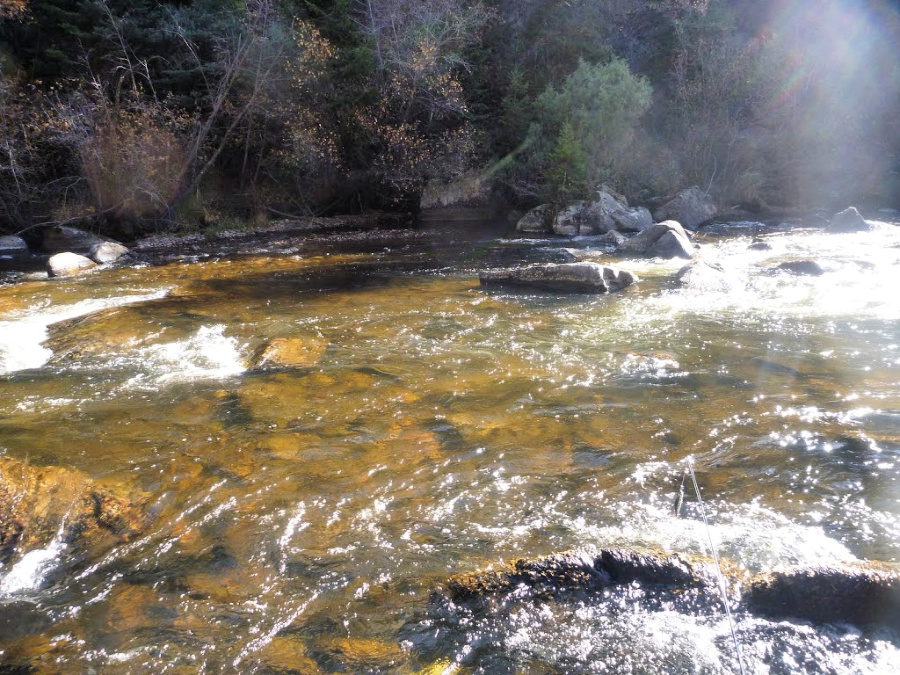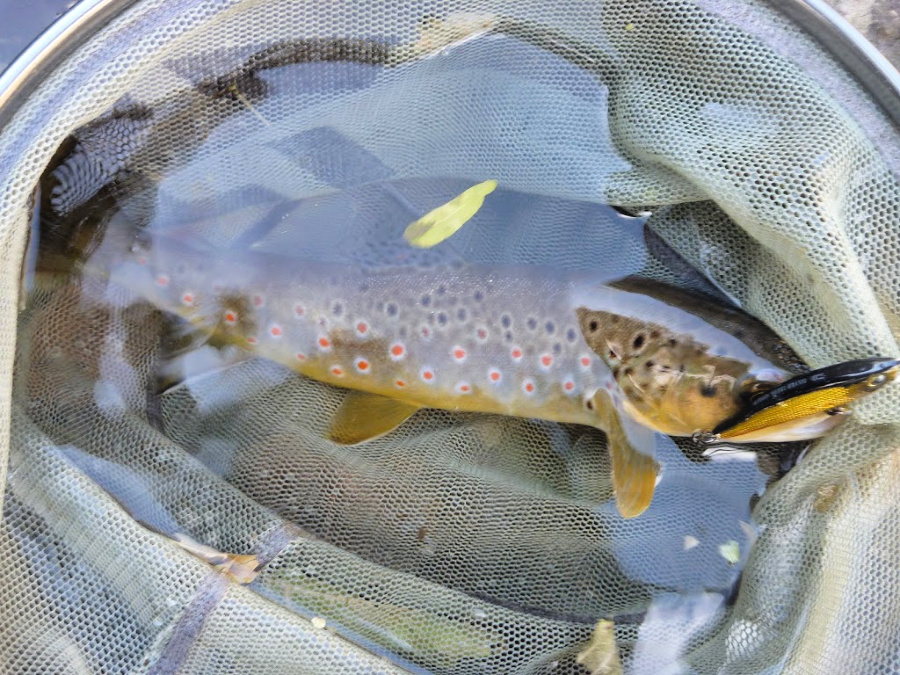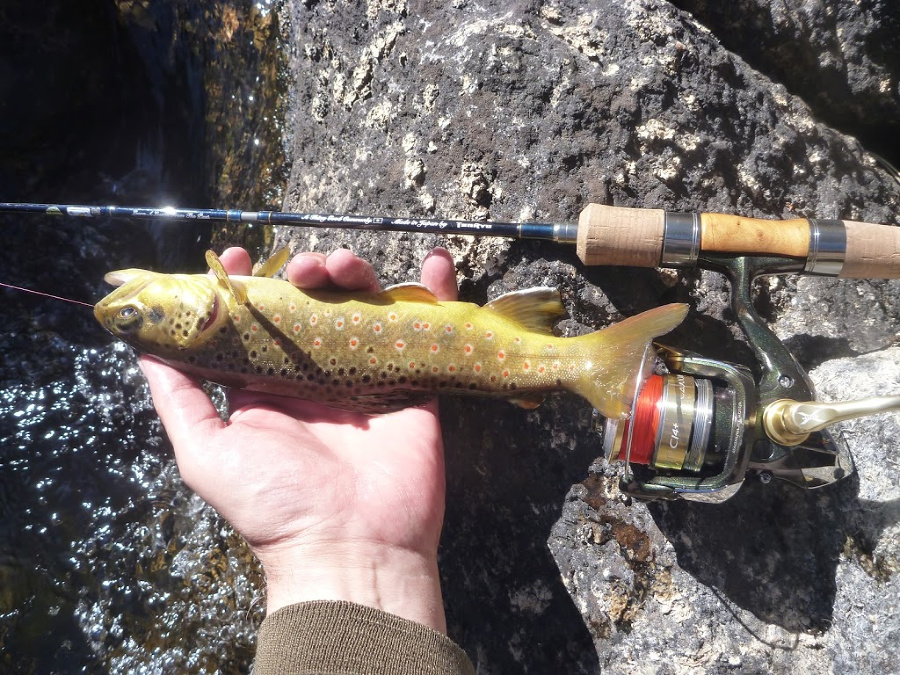The Flip Cast
I'd heard of the Flip Cast, but I couldn't do it. I just couldn't get the timing right.
Please note: this is not the same as the flip cast used by bass fishermen, (for which you pretty much couldn't get the timing wrong). It is also not the "underhand flip cast" that Frank Nale teaches. To minimize confusion between the two very different casts, I've chosen to call what Frank does a Pitch Cast.
This essay is taken from the 10-19-19 Trip Report, which chronicled a trip to Colorado during which Adam K taught me how he does a flip cast.
 The "classroom"
The "classroom"When we got down to the stream, Adam showed me his flip cast. Based on our previous conversations, my understanding of how he did it had been close, but not exact, and the difference was crucial.
With a flip cast, the rod is held directly in front of you, essentially pointing straight at your target. Start with a sharp (but short!) upward motion of the rod tip and then a more forceful sharp downward motion with your wrist. The upward motion may be counter-intuitive, but the final goal is to load the rod with the rod tip and lure below the rod (which is how you will achieve a low trajectory).
The upward motion loads the rod a little, with the lure above the rod. The sharp downward motion of your wrist then whips the lure from above the rod to below the rod. When your downward wrist motion stops abruptly, the momentum of the lure bends the tip further down and back, which is what seriously loads the rod. A very slight forward push with your hand loads the rod a bit further (because the inertia of the lure holds it back very briefly). You release just as the rod tip begins to recover. If you have timed your release perfectly, the lure will shoot towards your target with a very flat trajectory.
The part I hadn't understood was the slight forward push. I had been trying a slight upward motion of the wrist, which generally caused the lure to go much too high. Also, my release had generally been a fraction of a second too late.
[Reading this report months later,
I just realized that the slight forward push that Adam uses has the
same effect as the forward motion that Erne St. Claire described in his
Fer de Lance cast. Adam's cast is not the Fer de Lance cast, but as with the Fer de Lance cast, that
forward motion of his hand does use the lure's inertia to load the rod a bit more.]
The big advantages of a flip cast are: 1) there is
very little movement of the rod or your arm, so you are much less
likely to scare the fish you are trying to catch; 2) done well, the low trajectory
can deliver the lure under overhanging tree branches; 3) because your
rod starts out pointing directly at your target, your cast should always
go directly towards your target. Distance and elevation take practice,
but side to side accuracy should be right on almost from the
beginning.
A good flip cast takes a lot of practice (timing the release is absolutely critical). I didn't get the timing right for every cast, but I got it right often enough to understand what I needed to do and what I needed to practice.
I'd started the lesson with Adam's Anglo & Co rod, which he had said does the flip cast very well. The best part of the lesson (at least for me) was after making the cast correctly a few times with his Anglo & Co rod, I was able to pick up my Tenryu Rayz Integral RZI50UL-4 and do the exact same cast. (The Tenryu Rayz Integral RZI50UL-4 has been replaced by the RZI484S-UL.)
You do need to get the timing of the release just right, but you also need a rod that is soft enough to load with just the quick downward wrist flick and slight forward push. The RZI50UL-4 worked just fine. Not to mention (OK, I'll mention it), the Tenryu Rayz Integral RZI50UL-4 is about half the cost of an Anglo & Co rod and there's no four-month wait!
 A 4.5 gram sinking minnow lure.
A 4.5 gram sinking minnow lure.Although the Tenryu RZI50UL-4 is rated for lures as light as 1 gram
(roughly 1/32 oz), you will need a heavier lure to make the flip cast
that Adam taught me. The key to the cast is loading the rod with the
sharp downward motion, and a light lure doesn't have enough mass to load the rod. A lure like the 4.5 gram Palms Alexandra is about right.
A lure of about 4.5g also allows you to make longer casts, so you can target the bank eddies on the far side. If you can get the lure deep into a bank eddy, it probably won't land directly on top of a fish, scaring it, but will allow you to fish the seam between the eddy and the main current, as well as the full width of the stream back to where you are standing. In a stream like the one we fished, with lots of large rocks both above and below the surface (top photo), you could pick up a fish about anywhere along your retrieve.
 One of many.
One of many.We both caught a lot of fish that day. For me, though, the lesson was far more important than the fish.
Update 5-1-25
I found a YouTube video that explains in great detail exactly how to do the flip cast with a spinning rod. Unfortunately, it is in Japanese, but if within YouTube you click on the closed caption icon [CC] and then click the settings gear, you can turn on auto-translate to get English closed captions. It's not perfect, but you can follow what he is saying.
What's even better about the video is that he does the demonstration with a Tenryu Rayz Integral RZI50-UL, the exact same rod I used when Adam was showing me what do do. Of course, the guy in the video is much, much better than I am at the flip cast!
https://www.youtube.com/watch?v=S0ogPtRd7cA
Home > Finesse Spin Fishing > The Flip Cast
Header photo: Tenryu Rayz RZ4102B-UL, Shimano Calcutta Conquest BFS-HG ('17)
Warning:
The hooks are sharp.
The coffee's hot.
The fish are slippery when wet.
Seriously, all the hooks sold on Finesse-Fishing.com, whether packaged as loose hooks or attached to lures, are dangerously sharp. Some have barbs, which make removal from skin, eyes or clothing difficult. Wear eye protection. Wear a broad-brimmed hat. If you fish with or around children, bend down all hook barbs and make sure the children wear eye protection and broad-brimmed hats. Be aware of your back cast so no one gets hooked.
Also, all the rods sold on Finesse-Fishing.com will conduct electricity. Do not, under any circumstances, fish during a thunder storm. Consider any fishing rod to be a lightning rod! Fishing rods can and do get hit by lightning!
Whatever you do, do it with finesse!